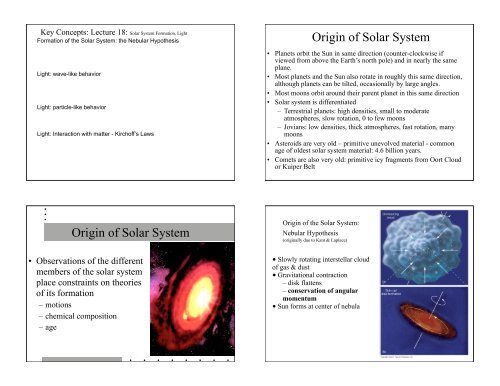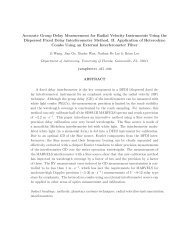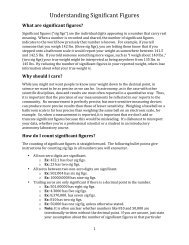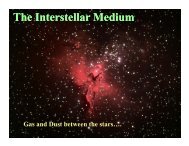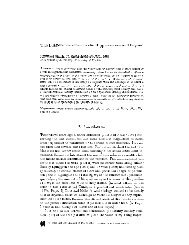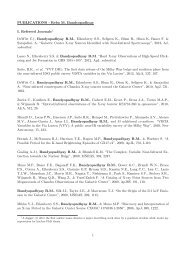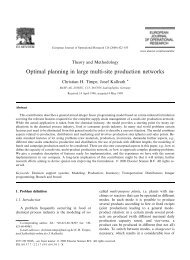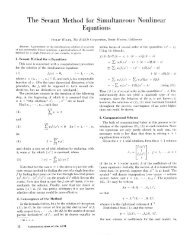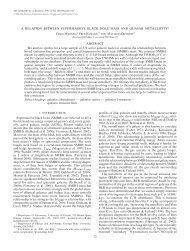Origin of Solar System Origin of Solar System
Origin of Solar System Origin of Solar System
Origin of Solar System Origin of Solar System
Create successful ePaper yourself
Turn your PDF publications into a flip-book with our unique Google optimized e-Paper software.
Key Concepts: Lecture 18: <strong>Solar</strong> <strong>System</strong> Formation, LightFormation <strong>of</strong> the <strong>Solar</strong> <strong>System</strong>: the Nebular HypothesisLight: wave-like behaviorLight: particle-like behaviorLight: Interaction with matter - Kirch<strong>of</strong>f’s Laws<strong>Origin</strong> <strong>of</strong> <strong>Solar</strong> <strong>System</strong>• Planets orbit the Sun in same direction (counter-clockwise ifviewed from above the Earth’s north pole) and in nearly the sameplane.• Most planets and the Sun also rotate in roughly this same direction,although planets can be tilted, occasionally by large angles.• Most moons orbit around their parent planet in this same direction• <strong>Solar</strong> system is differentiated– Terrestrial planets: high densities, small to moderateatmospheres, slow rotation, 0 to few moons– Jovians: low densities, thick atmospheres, fast rotation, manymoons• Asteroids are very old – primitive unevolved material - commonage <strong>of</strong> oldest solar system material: 4.6 billion years.• Comets are also very old: primitive icy fragments from Oort Cloudor Kuiper Belt<strong>Origin</strong> <strong>of</strong> <strong>Solar</strong> <strong>System</strong>• Observations <strong>of</strong> the differentmembers <strong>of</strong> the solar systemplace constraints on theories<strong>of</strong> its formation– motions– chemical composition– age<strong>Origin</strong> <strong>of</strong> the <strong>Solar</strong> <strong>System</strong>:Nebular Hypothesis(originally due to Kant & Laplace)• Slowly rotating interstellar cloud<strong>of</strong> gas & dust• Gravitational contraction– disk flattens– conservation <strong>of</strong> angularmomentum• Sun forms at center <strong>of</strong> nebula
Conservation <strong>of</strong> MomentumMomentum = mass x velocityOther examples <strong>of</strong> conservation<strong>of</strong> angular momentumReview Newton’s Laws <strong>of</strong> Motion (Lecture 9).Newton’s 1st Law implies momentum is conserved (i.e. isunchanging) if there are no forces acting on an object.Newton’s 2nd & 3rd Laws imply that if a force is applied theoverall momentum is also conserved (i.e. unchanged) sincethere is always an opposite force <strong>of</strong> equal strength.Conservation <strong>of</strong> Angular MomentumAngular momentum ! mass x rotation rate x radius 2An object <strong>of</strong> constant mass will spin faster as it contractsIce skater video….<strong>Origin</strong> <strong>of</strong> the <strong>Solar</strong> <strong>System</strong>• All cold interstellar gas we seetoday has some small dust grains.We think the pre-solar nebulawould have started with these also.• Growth <strong>of</strong> these grains to largersizes and eventually to formPlanetesimals• Gravity collects planetesimals t<strong>of</strong>orm Protoplanets• Formation <strong>of</strong> Jovians: Largeprotoplanets sweep up gas• Formation <strong>of</strong> Terrestrials: Smallerprotoplanets, in a warmerenvironment, not able to retainlarge amounts <strong>of</strong> Hydrogen gas
<strong>Origin</strong> <strong>of</strong> the <strong>Solar</strong> <strong>System</strong>• Planets form in disk <strong>of</strong>gas and dust near center<strong>of</strong> nebula.We can see other solar systems forming• See star formation section later in course- Orbits are all in same direction andplane. They are approximately circular.- Change in composition <strong>of</strong> planets isdue to changes in local temperature indisk: planets are forming viacondensation and accretion and disk iswarmer near the Sun, e.g. no solidwater ice inside about 4 AU.<strong>Origin</strong> <strong>of</strong> the <strong>Solar</strong> <strong>System</strong>• Asteroids– Remaining rocky planetesimals inthe inner solar system– Failed to become protoplanets dueto gravity <strong>of</strong> Jupiter• Comets– Remaining icy planetesimals inouter solar system -> Kuiper belt– Gravitational interactions withJovians flung planetesimals• Into inner solar system (deliveringsome water to Terrestrial planets)• To outer solar system – Oort cloudRecall: The Importance <strong>of</strong> Light• We can not hope to visit objects outside the solarsystem in our lifetime.• The easiest way we can learn about distant objectsis by studying the light they emit.• Using information in their light, we can measurecompositions, temperatures, distances, masses andages <strong>of</strong> astronomical objects.• As light travels at a finite speed, by lookingfurther and further away we look back further andfurther into the past.
The Wave Nature <strong>of</strong> Electro-Magnetic Radiation• Visible light is justone form <strong>of</strong> electromagneticradiation• Light <strong>of</strong>ten behaveslike a wave– Diffraction: wavesbend around obstacles– Interference: wavesadd their amplitudestogetherRecall: Properties <strong>of</strong> Waves• A wave is described by four properties– The wavelength (") - units <strong>of</strong> length– The amplitude <strong>of</strong> the wave– The speed <strong>of</strong> the wave (c) - units <strong>of</strong> speed length/time– The frequency <strong>of</strong> the wave (f) - units <strong>of</strong> 1/time• Three <strong>of</strong> these properties are interrelated: c = f x "Recall: Wave Nature <strong>of</strong> Electro-Magnetic RadiationAll EM radiation is composed <strong>of</strong> two waves that move together– An electric field and a magnetic field– The fields are at 90 degrees to each other– It needs no medium to be transmitted through, i.e. it can travel through avacuum– Energy is carried by the waveRecall:•EM spectrumextends fromradio to gammarays•The Earth’satmosphere onlytransmits certainfrequencies
Light Also Behaves Like A Particle!• When light interacts with matter, it<strong>of</strong>ten behaves like a particle• A particle <strong>of</strong> light is called a Photon• First suggested by Max Planck (1899)– The energy <strong>of</strong> a particle <strong>of</strong> light (photon)depends only on its frequency– h is a constant known as Planck’s constant• Photoelectric effect - Einstein (1905)– Certain metals emit electrons when exposed tolight• basis <strong>of</strong> exposure meters, night vision gogglesetc...– This only happens when a high enough frequency(i.e. short enough wavelength) light is used,because a certain amount <strong>of</strong> energy is needed t<strong>of</strong>ree each electron from the metal and that energymust come from a single photon <strong>of</strong> high enoughenergy. Lots <strong>of</strong> low energy photons don’t work.E = h x fWave-Particle Duality VideoWave-Particle Duality• Light sometimes behaves like aparticle, sometimes like a wave.• Traditional “particles”, e.g.electrons, protons, bullets, whenmoving also sometimes behavelike waves, but the effects are onlynoticeable on scales <strong>of</strong> thewavelength, which are typicallyminiscule and too small to see ineveryday life.• Quantum mechanics describes thebehavior <strong>of</strong> these “waveparticles”.All objects have thisbehavior, but in everyday life wedon’t notice it.particle-likewave-likeThe Interaction <strong>of</strong> Light with Matter• Matter is composed <strong>of</strong> atoms– Atoms have nuclei composed <strong>of</strong>Protons (+ve electric charge)Neutrons (neutral)– The nuclei are surrounded by a cloud <strong>of</strong>Electrons (-ve electric charge)– The number <strong>of</strong> protons determines whatelement it is. To be electrically neutral thenumber <strong>of</strong> electrons must equal thenumber <strong>of</strong> protons• Light typically interacts with matter byinteracting with the electrons around atoms
The Interaction <strong>of</strong> Light with Matter• The possible energies whichan electron can have arequantized: only certainparticular energies areallowed.• Electrons and photons canexchange energy– An atom can absorb aphoton by moving anelectron to a higher energystate– An atom can emit a photonby an electron moving to alower energy state– The change in the energy<strong>of</strong> the electron mustexactly equal the energy <strong>of</strong>the photonFinger Printing the Elements• Each type <strong>of</strong> atom (i.e. different elements likeHydrogen, Helium, Carbon, Oxygen, etc) has aunique configuration <strong>of</strong> electrons• Each type <strong>of</strong> atom has a unique set <strong>of</strong> possible energylevels• Each type <strong>of</strong> atom emits and absorbs photons with aunique pattern <strong>of</strong> energiesThe Stair Case AnalogySpectra <strong>of</strong> Atoms• You can think <strong>of</strong> the levels <strong>of</strong> anatom as being like a flight <strong>of</strong>stairs• To step up to a higher levelrequires enough energy to lift youone or more stairs• When you come back down thestairs you give up the energy yougot by going up the stairsf
Kirchh<strong>of</strong>f’s Laws• Gustav Kirch<strong>of</strong>f derived three lawsto explain how matter and lightinteract• He noted that three types <strong>of</strong> spectraarise under different conditions– Continuous spectra– Emission line spectra– Absorption line spectraWien’s Law• Wien’s law tells you at whatwavelength (or frequency) theblackbody spectrum peaks(has the maximum value)– Hotter objects emit light thatpeaks at shorter wavelengths(higher frequencies & higherenergy photons)– Colder objects emit a spectrumthat peaks at longer wavelengths(lower frequencies & lowerenergy photons)" max = 0.29cmT (K)The Generation <strong>of</strong> Light• All dense matter with a temperature above absolute zero emits light because<strong>of</strong> vibrating electric charges (electrons)• The spectrum is the amount (intensity) <strong>of</strong> light at different frequencies (orwavelengths)• The peak <strong>of</strong> the spectrum dependson the temperature:hotter temperature leads to peak athigher frequencies (shorter wavelengths)• This is calledBlackbody Radiationwhich is an example <strong>of</strong> acontinuous spectrumUse <strong>of</strong> Wien’s LawWe can use Wien’s law to find the temperatures <strong>of</strong>distant bodies we can never visit, by measuring thewavelength (or the frequency) at which the spectrumpeaks.
• A hot and opaquemedium emits acontinuous spectrum,because the atoms arevery close to eachother which smearsout the energy levels.• This is the blackbodyspectrumKirchh<strong>of</strong>f’s 1 st Law• If a continuous spectrumpasses through a transparentgas at a lower temperature,the cooler gas will cause theappearance <strong>of</strong> darkabsorption lines, whosecolors and number willdepend on the elementspresent in the gas• This is because particularenergies are absorbed by thecool gas (electrons are raisedto higher energy levels). Thenwhen the electrons fall downand new photons emitted,these photons can go in anydirection: most do not gothrough the slit.Kirchh<strong>of</strong>f’s 3 rd LawAn absorption spectrumis produced when lightpasses through a cold gas• A hot, transparent, lowdensitygas produces aspectrum <strong>of</strong> bright emissionlines. The number and colors<strong>of</strong> the lines depend on whichelements are present. Becausethe atoms are quite far apartthe energies <strong>of</strong> the photonsare not smeared out.• The emission lines are due toelectrons moving from higherto lower energy statesKirchh<strong>of</strong>f’s 2 nd LawSummary <strong>of</strong> Kirch<strong>of</strong>f’s Laws


